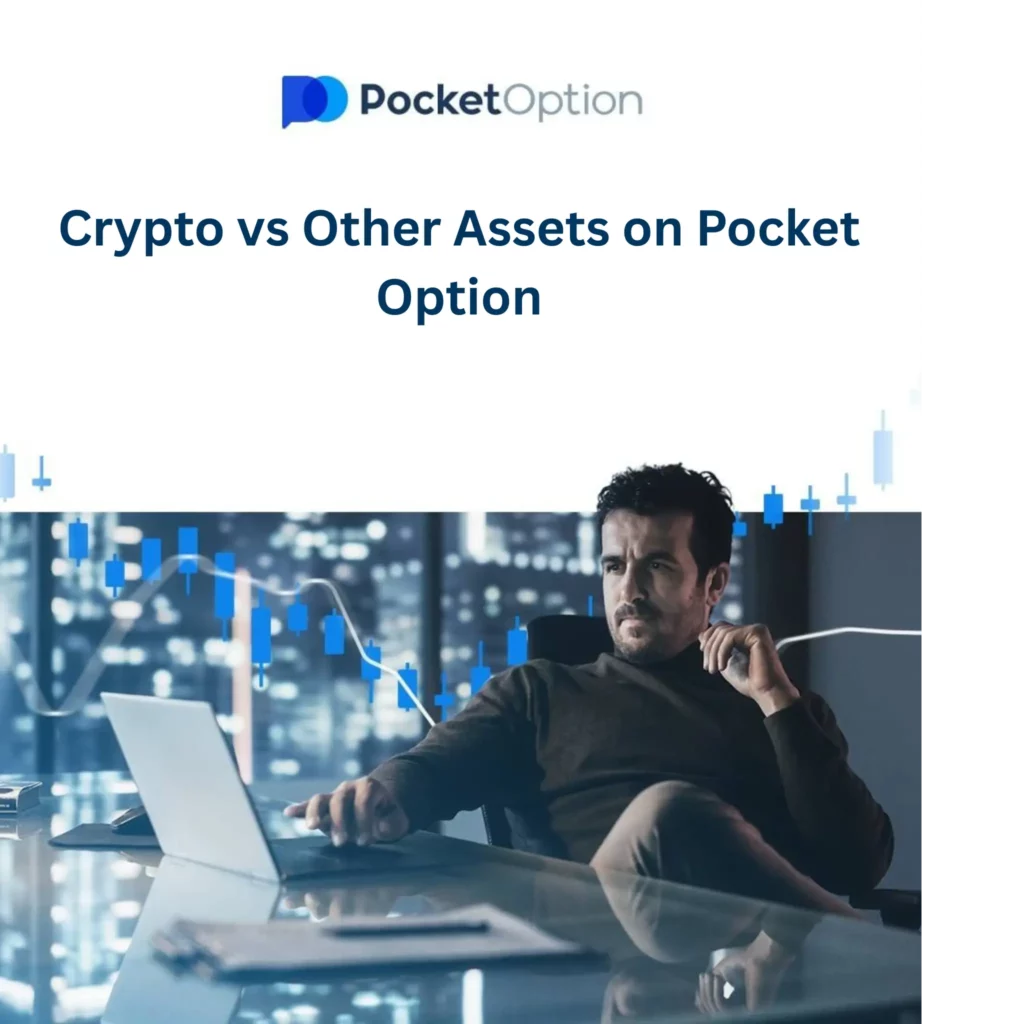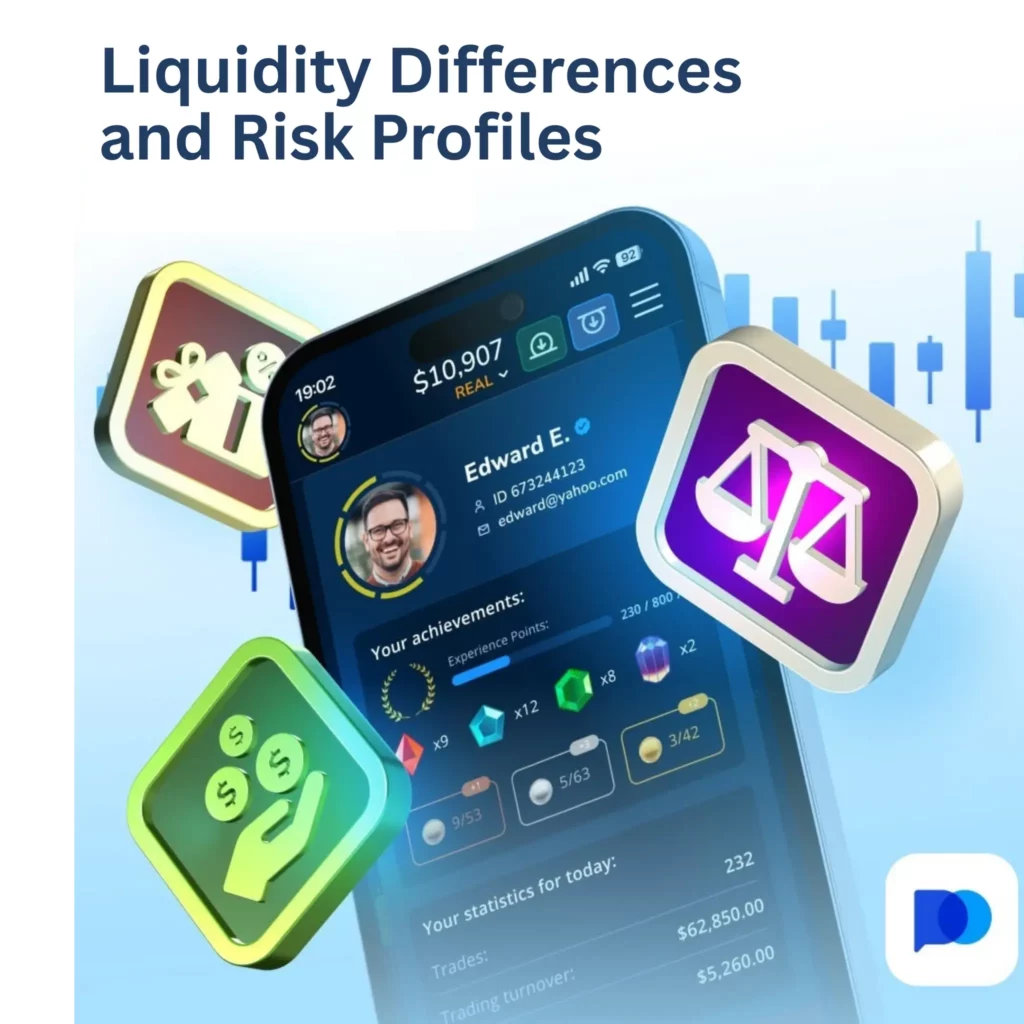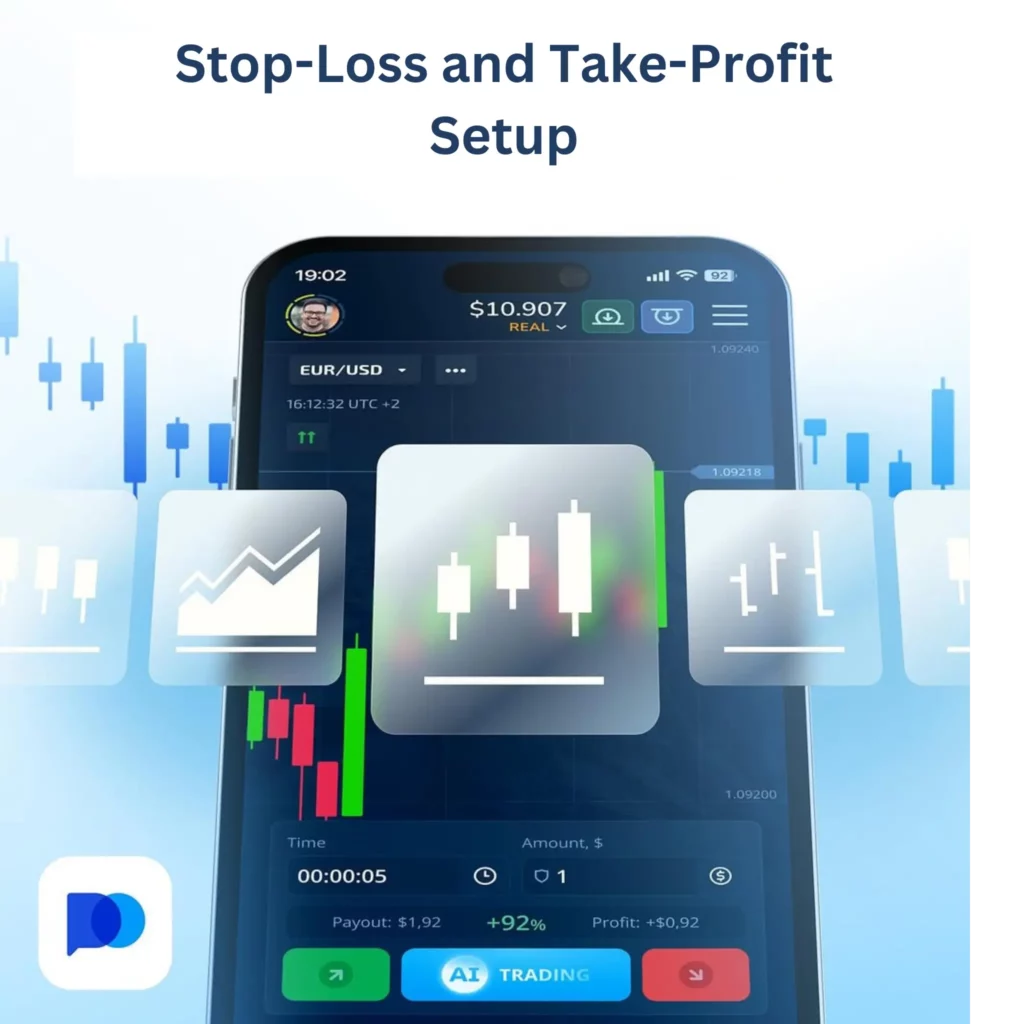Crypto Trading on Pocket Option: Full Guide for Beginners and Experts
Crypto trading on Pocket Option lets you buy and sell digital assets in real time. This guide explains how it works, what tools are available, and how to trade safely and effectively — whether you’re just starting or already experienced. It also covers market features, top coins, and strategies tailored to the crypto space.
Table of Content Pocket Option Crypto Trading
- What Is Crypto Trading on Pocket Option?
- Main Features of Crypto Trading
- Popular Cryptocurrencies on Pocket Option
- How to Start Crypto Trading on Pocket Option
- Crypto vs Other Assets on Pocket Option
- Effective Strategies for Cryptocurrency Trading
- Risk and Capital Management
- Tools for Crypto Analysis on Pocket Option
- Frequently Asked Questions (FAQ)
What Is Crypto Trading on Pocket Option?
Crypto trading on Pocket Option involves speculating on the price movement of cryptocurrencies like Bitcoin, Ethereum, and others. You trade using binary options or digital contracts, choosing direction (up or down), amount, and expiration time. The platform provides real-time charts, technical indicators, and constant market access — even on weekends.
Main Features of Crypto Trading
Cryptocurrency markets operate differently from traditional assets. Pocket Option adapts to these differences by offering unique features for crypto traders.
24/7 Market Availability
Unlike forex or stocks, crypto markets never close. You can trade anytime — day or night, weekday or weekend. This flexibility suits users in all time zones and allows constant access to trading opportunities.
High Volatility and Fast Price Swings
Cryptos are known for sharp and frequent price moves. This creates more opportunities for short-term trades, but also increases risk. Traders often use quick setups, tight controls, and volatility-based strategies.
Wide Selection of Digital Assets
Pocket Option offers a growing list of cryptocurrencies, including:
- Bitcoin (BTC)
- Ethereum (ETH)
- Litecoin (LTC)
- Ripple (XRP)
- Dogecoin (DOGE)
- Tether (USDT) and other stablecoins
Each asset has unique behavior, so you can pick based on volatility, news impact, or long-term trend.
Multiple Chart Types and Technical Tools
You can switch between chart styles like:
- Line
- Candlestick
- Bar
- Heiken Ashi
Each helps spot trends differently. Combine them with indicators like RSI, MACD, Bollinger Bands, and volume tools — all available in real time. This setup supports both fast scalping and longer-term analysis.
Popular Cryptocurrencies on Pocket Option
Pocket Option features a diverse range of cryptocurrencies for trading. Each one offers different price behavior, volatility levels, and use cases — giving traders a wide selection to choose from.
The most traded and well-known cryptocurrency. Bitcoin is highly volatile and often drives movement across the entire crypto market. It’s ideal for both short-term setups and trend-following strategies.
ETH is the second-largest crypto by market cap. It has fast movement, strong technical levels, and frequent news impact — making it a favorite among active traders.
Often called “digital silver,” Litecoin moves faster and with lower transaction fees than Bitcoin. It typically shows clean technical patterns and reacts well to key support and resistance zones.
Ripple is designed for cross-border payments and has unpredictable spikes due to legal news or partnerships. XRP is popular for short-term trading thanks to sudden bursts of volatility.
Originally a meme coin, Dogecoin remains highly speculative. It often reacts to social media and celebrity mentions, so it’s best suited for high-risk, event-driven trades.
Tether (USDT) and other stablecoins are used for preserving value and reducing volatility. While not typically traded for profit, they’re useful for switching in and out of crypto positions without converting to fiat.
How to Start Crypto Trading on Pocket Option
Trading crypto on Pocket Option is simple and beginner-friendly. You can get started in just a few steps.
Step 1: Open and Verify Your Account
Sign up on the Pocket Option platform. Then complete identity verification — this unlocks access to deposits, withdrawals, and full trading functionality.
Step 2: Make a Deposit in Fiat or Crypto
Choose a payment method. You can deposit using a bank card, e-wallet, or cryptocurrency. Pocket Option accepts direct crypto deposits including BTC, ETH, and USDT.
Step 3: Navigate to the Crypto Market
Go to the main trading interface and select “Crypto” in the asset filter. You’ll see all available coins along with payout percentages and trading options.
Step 4: Analyze the Asset and Place a Trade
Use indicators, sentiment tools, or chart patterns to plan your entry. Then set trade size, direction (Up or Down), and expiry. Confirm the trade to enter the market in real time.
Crypto vs Other Assets on Pocket Option
Cryptocurrencies behave differently from other asset classes like forex, stocks, or commodities. Understanding these differences helps you adjust your trading approach.

Trading Hours
- Crypto: Available 24/7, including weekends and holidays.
- Other Assets: Follow market sessions (e.g., forex closes on weekends, stocks follow exchange hours).
Crypto’s round-the-clock access gives more flexibility but can lead to unexpected moves at off-peak times.
Volatility and Speed
- Crypto: Known for fast price swings, often reacting to news, tweets, or market sentiment.
- Other Assets: Usually show more predictable behavior, especially in regulated markets.
This makes crypto suitable for short-term trades, but it also increases risk.
Liquidity Differences
- Crypto: Liquidity varies by coin. Major assets like BTC and ETH have deep markets; smaller coins may suffer from slippage.
- Other Assets: Generally more stable liquidity, especially in forex and large-cap stocks.
Check the payout rate and execution speed before placing trades on less popular crypto pairs.
Risk Profiles
Crypto assets tend to carry:
- Higher reward potential
- More extreme drawdowns
- Greater exposure to speculation and emotional trading
Use stricter risk management compared to traditional markets.

Effective Strategies for Cryptocurrency Trading
Because crypto markets move fast and often react emotionally, these strategies work well in the Pocket Option environment.
Scalping in High Volatility Periods
Scalping means entering and exiting trades quickly — often within minutes. Look for rapid price spikes after news or technical breakouts. Use 15s–1min timeframes with indicators like Bollinger Bands or RSI for entry confirmation.
Trend Following with Technical Indicators
Combine moving averages (e.g., EMA 9 and EMA 21) with MACD or RSI. Enter in the direction of the dominant trend and use breakouts or pullbacks as trigger points.
Support and Resistance Zones
Mark key horizontal levels and wait for price to react. If a coin bounces off support or rejects resistance, look for reversal signals like doji candles or volume surges.
News-Based Trading (Fundamentals)
Crypto reacts strongly to announcements — exchange hacks, legal rulings, adoption news, or tweets. Monitor headlines and act fast, especially with short expiries.
Holding and Long-Term Positioning
For less active users, consider holding trades longer based on daily or weekly trends. Look for coins with upward momentum and strong use cases. This approach requires larger buffers and emotional control.
Risk and Capital Management
Managing risk is essential in crypto trading, where price swings are frequent and unpredictable. A good strategy isn’t just about entries — it’s about protecting your capital across many trades.
Position Sizing per Trade
Decide how much to risk on each trade. A common rule is to risk no more than 1–2% of your total balance per position. This helps absorb losses without wiping out your account.
| Account Size | 2% Risk per Trade | Max Trade Size |
|---|---|---|
| $100 | $2 | Small trade |
| $500 | $10 | Moderate trade |
| $1000 | $20 | Higher risk |

Stop-Loss and Take-Profit Setup
Set clear limits for when you’ll exit a trade — both if it goes wrong (stop-loss) and when it goes right (take-profit). For example:
- Stop-loss: after a key support level breaks
- Take-profit: near a resistance or payout target
Don’t move your stop once a trade is live — that usually leads to bigger losses.
Avoiding Overtrading and Emotional Decisions
Crypto’s nonstop nature tempts traders to take too many trades. Signs of overtrading include:
- Trading without a setup
- Chasing losses
- Opening multiple trades at once without a plan
Stick to your strategy, and take breaks after wins or losses to reset your mindset.
Diversifying Across Multiple Cryptos
Don’t rely on a single asset. Split your capital across 2–3 coins with different characteristics (e.g., BTC + ETH + DOGE). This reduces the impact of one bad trade and gives you more chances for profitable setups.

Tools for Crypto Analysis on Pocket Option
Pocket Option offers real-time tools to help you analyze the crypto market and plan smarter trades.
Technical Indicators (RSI, MACD, Bollinger)
Use these built-in indicators to identify trends, reversals, and trade timing:
- RSI shows overbought/oversold zones
- MACD confirms trend direction and momentum
- Bollinger Bands reveal volatility spikes and breakout areas
You can customize settings to fit your strategy and apply multiple indicators at once.
Sentiment Tools
Sentiment widgets show how other traders are positioned — for example, how many are placing “Up” vs “Down” trades. It’s not a signal on its own but can help confirm or question your plan.
Economic Calendar for News-Based Events
Track crypto-related news such as regulatory updates, central bank meetings, and inflation data. These events can trigger sharp price moves, especially in major coins like BTC or ETH.
Multi-Timeframe Charting
Switch between chart timeframes — from 15 seconds to 1 day — to align short-term trades with longer trends. This helps you:
- Confirm entry direction
- Spot conflicting signals
- Time trades more precisely
Multi-timeframe analysis gives better context and improves decision quality.
Frequently Asked Questions (FAQ)
Do I need previous experience to trade crypto?
No, you don’t need prior experience. Pocket Option provides a user-friendly platform, and you can start with small amounts while learning. However, understanding basic trading principles and managing risk is highly recommended.
What is the minimum deposit for crypto trades?
The minimum deposit varies by payment method but typically starts at $10. You can deposit using fiat currencies or supported cryptocurrencies like Bitcoin, Ethereum, or USDT.
Can I trade crypto on weekends?
Yes, you can. The crypto market is open 24/7, including weekends and holidays. This makes it one of the few asset types available for continuous trading.
What are the risks of trading crypto assets?
Crypto trading carries risks like high volatility, rapid price swings, and unexpected news events. Poor risk management or emotional decisions can lead to significant losses.
Which cryptocurrencies are best for short-term trading?
Bitcoin (BTC) and Ethereum (ETH) are popular for short-term trades due to liquidity and consistent volatility. Dogecoin (DOGE) and Ripple (XRP) can also be good options during news-driven moves.
